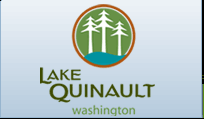Lake Quinault History
History of Lake Quinault
The only temperate rain forest in the northern hemisphere includes the glacial carved Quinault Valley. The Native Americans who inhabited the area had few physical wants because the climate was moderate and the land and the sea were so abundant.
“The people were surrounded by a large variety of sea, land, and plant foods, many sources of clothing, and many woods for huge longhouses, trees to carve into sea and river-going canoes, or natural tools to engrave a cedar box, fell a 1,000 year old tree, or ladle food.”
The Lake Quinault area and the upper Quinault Valley were used seasonally to gather materials and foods such as berries, fish and meat. The Quinault River was the main transportation route into the valley.
The first white settler to come into the valley was Alfred Noyes who came up the river with the Indians in 1888. He built a cabin at what is now “Lockes Landing” and spent the winter of 1888 – 1889 trapping.
In July of 1889, Joseph N. Locke came overland from Montesano, where a friend had told him of the “Wonderful Quinault Valley,” a nine day trek. He built a cabin and posted notice of a “claim” on August 8, 1889. Phil Locke related that various others began to settle on claims at the head of the lake at this same time including Jack and Albert Pruce, Jim Kelly, Alfred Noyes, Jack Ewell, and Harry West.
The Seattle Press-Times Expedition straggled into the Quinault Valley in May 1890 and a special edition of the paper covering the exploration stimulated considerable interest in the area. The next Government Expedition came over the mountains from Hoodsport, and was led by Lieutenant O’Neil. Alfred V. Higley and Orte L. Higley followed the O’Neil party’s trail from Hoodsport and arrived in the Quinault Valley in the fall of 1890.
The Quinault Townsite was platted in July 1890 by O.G. Chase and Ogden. The first Hotel was built in 1891 and was run by O. L. Higley in a building built by the Quinault Townsite Company (about where the U.S. Forest Service maintenance buildings currently are located).
“In 1891, Anton Kestner took a homestead at Quinault. The following year, 1892, Josepha with their two sons joined him. They landed at Oyehut, followed the beach to Taholah, and took a canoe up the Quinault River. The journey to their claim on the north side of the valley above the lake, consumed about a week.”
Mrs. Chesney was the first white woman in Quinault, Mrs. Julius Locke, the second, and Mrs. Laurence Slover the third.
“The public school in Quinault opened for a six month term with Miss Ida Locke as the teacher. The school cannot run in winter on account of the children not being able to go through the winter storms.” “In January 1893 , we got our first big snow. Frank Ziegler was carrying the mail,…it took four days to make the trip.”
John and Bothilda Olson settled 8 miles above the Lake in 1895. With them were two of John’s older children from his first wife and seven of the 13 children that Bothilda would bear; Fritchiof, Richard, Constance, Elma, Ignar and the 2 month old twins, Petranella (Nellie) and Rosella (Sellie).
The fortitude and resourcefulness of all the original settlers in the Valley defy modern imagination. The dense forest, the ferocious weather, the tumultuous river as a highway and the long muddy primitive trails that led into the area were daunting. How these sturdy folk carved out a homestead, built a home, beat down the brush to scratch out a garden and a field for their animals is astonishing, and THEY DID IT! Today there are many descendants of these Pioneers still here in the Quinault Valley and the surrounding communities.
Excerpted from: Trails and Trials of the Pioneers of the Olympic Peninsula; Land of the Quinault; and Land of the Trees by S. Criss Osborn.



